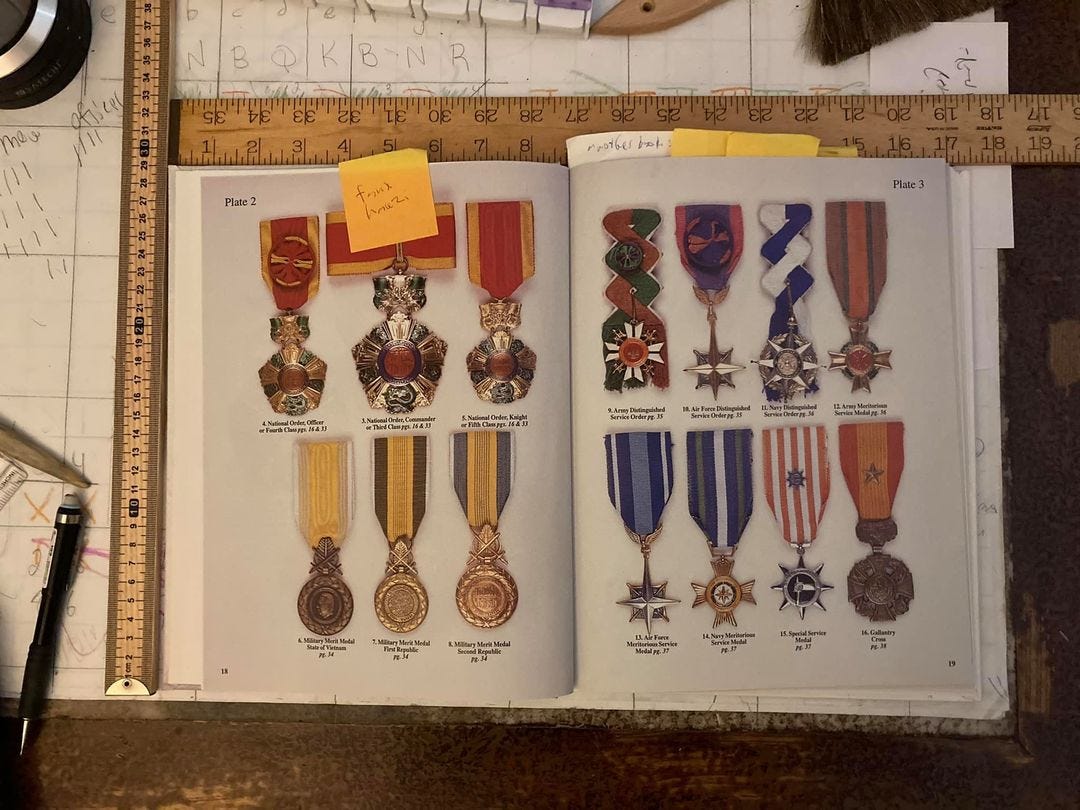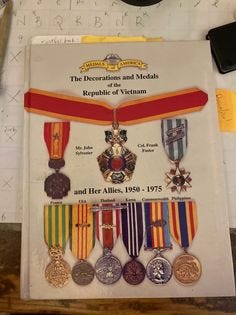The Decorations and Medals of the Republic of Viet Nam (iii)
from John Sylvester, State, and Frank Foster, Army
Recto, bottom row, second from right. Army colonel Frank C. Foster and State counter-insurgent John Sylvester, Jr. translate the name of the decoration as the Special Service Medal.
Special Services in our army was show business, and remains so among our Marines. The special in the Vietnamese is that of a specialty of a region or restaurant, both characteristic and exceptional.
It is also the special in our Special Forces at that time, and in our Special Operations today. Note two anachronisms, anomalies in the relation of that use of the word special to the one on this medal.
First, our Special Forces served with national minorities of the Republic of Viet Nam, in strained relations with our Vietnamese allies. Second, our Special Operations these days are the open policy of the United States of America at war, while back in the day they were secret.
I further demur from the word translated as service. The Vietnamese word means work generally. The name Special Air Service, commandoes of the United Kingdom, was a rough joke at the time they began destroying German aircraft on the ground.
The word is cong. Not quite the same word as in Viet Cong, which there refers to the community of work, but overlapping.
"Purpose: For military personnel, government employees, and civilians who distinguished themselves in extraordinary deeds or accomplished an important mission that involved risk of life and required exceptional fortitude and aggressiveness - generally of a clandestine nature. Also presented to foreign military personnel serving by the side of RVN units. Five combat missions north of the 17th parallel qualified RVN personnel for this medal."
5 north of the 17th? And the authors rate this medal as R-5, middling rare. So RVN was running many many civilians, civil servants, and soldiers into the Democratic Republic?
And they came back? Well, right across the frontier overland was the most dominated population behind the iron curtain. I have never heard of anyone sent there in the war coming back in a timely manner.
Do they mean to the supply lines in Laos? Maybe, but as I say local hill people patrolled there with our own Special Forces, hostile to DRVN and RVN alike.
I am guessing you got one of these for raiding 5 times along the coast. RVN attacked so the US could watch the DRVN defend, for instance the ghosts that the Maddox saw in the Gulf of Tonkin and the Congress followed to war.
I am glad, and intrigued, that so many of our allies returned so many times.
"Description: Front: silver eight-pointed star, 40 mm, with central planchet enameled black, with a hand holding a dagger pointing down in silver, surrounded with silver ribbon inscribed about BIỆT-CÔNG BỘI-TINH; Back: stamped VIỆT-NAM in a lined circle..."
I call an 8-pointed star a compass rose. That seems appropriate to what I conjecture were boat raids. The RVN navy medals use that star. That dagger is arresting.
It has the distinctive pommel, a skull-crusher, of our army's V-42 fighting knife, but the more robust blade of the Foreign Legion's, and our Marines' KA-BAR. Perhaps that of the Japanese army, or the KMT.
It is a stylized representation of something ideally no one ever sees. The proper use of one of these things is in the back, on a sentry or any man, woman, or child the party of raiders comes across who might raise the alarm.
So, there you have it. Well if you do I would like to hear from you. The Wet Work Medal.
This was third post of 6 so far on The Decorations and Medals of the Republic of Viet Nam by John Sylvester and Frank Foster. The first posted on February 21, 2022, the second on March 14, 2022, then the fourth on May 9, 2022, the fifth on June 13, 2022, and the sixth on May 18, 2023.
Viet Nam letters respects the property of others under paragraph 107 of United States Code Title 17. If we asked for permission it wouldn’t be criticism. We explain our fair use at length in the letter of September 12, 2022.
The colophon of these Viet Nam letters, directly above, shows the janitor speaking with poet David A. Willson on a Veterans Day.






